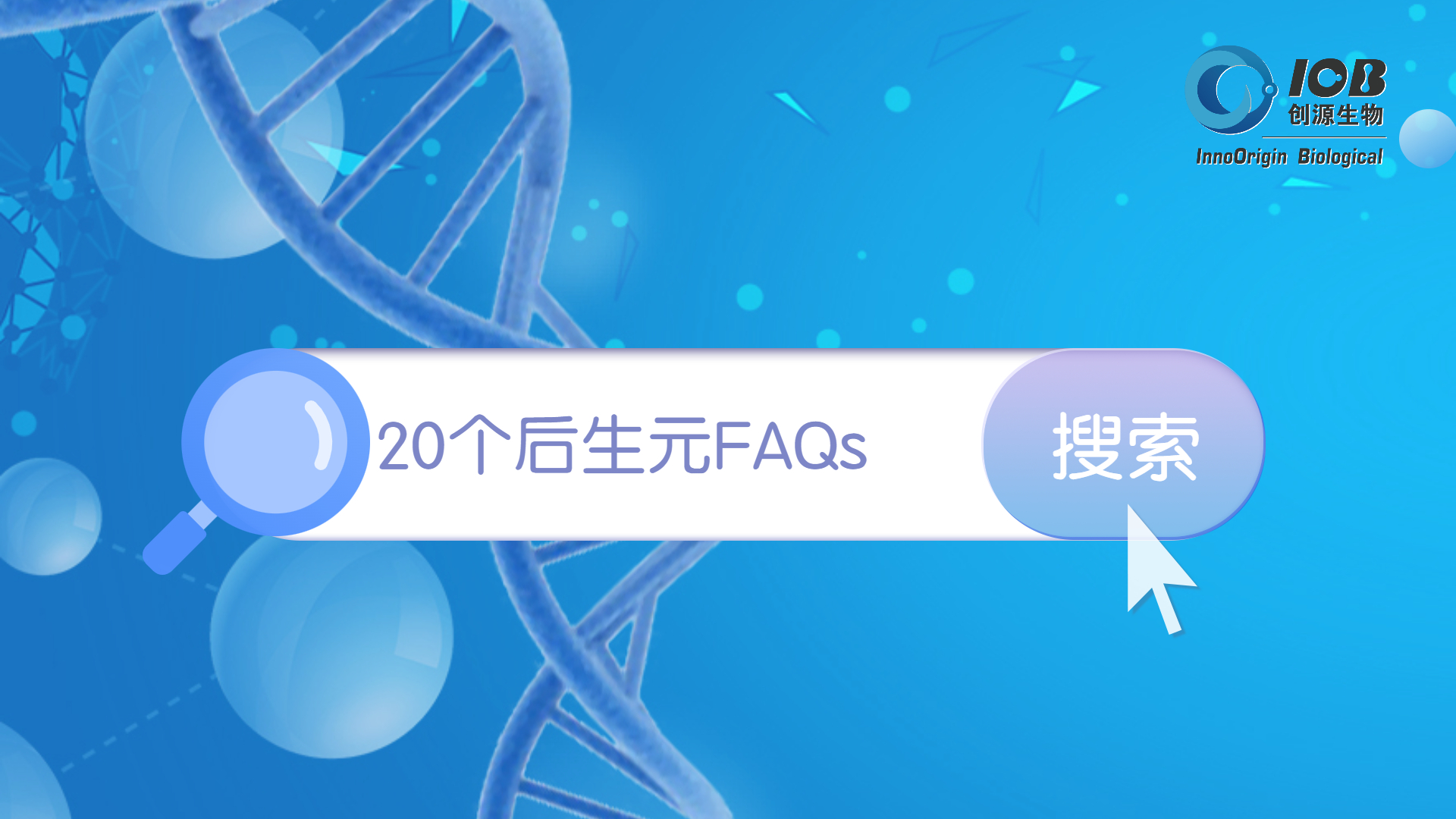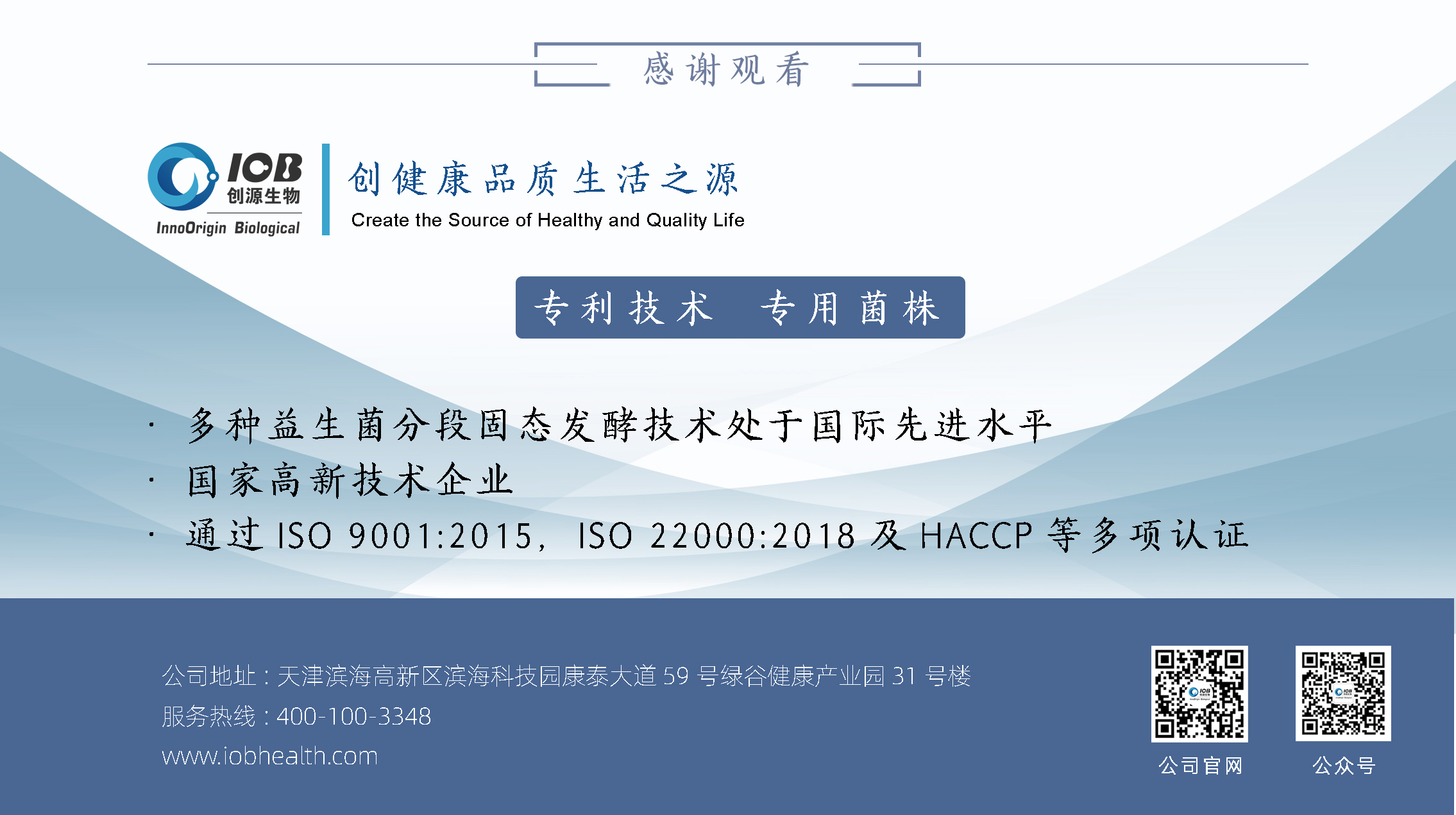 《20个后生元FAQs(下)》——后生元临床研究及使用情况
《20个后生元FAQs(下)》——后生元临床研究及使用情况
五、机制及临床研究
16 后生元和益生菌的有益作用相似,但其不用依赖于细菌的活性,那么后生元发挥作用的机制是什么?
根据已有的研究,ISAPP共识将后生元发挥作用的机制总结如下:
A. 对微生物组的有益调节。
B. 增强上皮屏障功能。
C. 对免疫反应的调节。
D. 对全身代谢的调节。
E. 作用于神经系统。
17 后生元可用于哪些疾病的预防和治疗,目前的临床研究情况如何?
目前后生元研究仍处于初期,人体研究数据较为有限,探究的后生元主要为灭活后的鼠李糖乳杆菌、嗜酸乳杆菌以及双歧杆菌,研究的疾病主要有胃肠道疾病、肥胖、皮肤过敏、压力管理等。
(1)胃肠道疾病:有多项临床研究探究了后生元对肠易激综合征(IBS)的改善效果。如2020年,发表在The Lancet Gastroenterology and Hepatology杂志上的一项多中心、随机、双盲、对照临床试验发现,每天口服1次灭活的两歧双歧杆菌MIMBb75可以显著改善IBS症状。
此外,还有部分研究探究了后生元对腹泻的作用,如2014年的一项荟萃分析显示,热灭活嗜酸乳杆菌 LB 可缩短住院患儿的腹泻持续时间。虽然有多项研究支持了多种后生元缓解腹泻的效应,但是这其中的机制仍不明确,且有部分试验结果之间存在矛盾之处,仍需进一步的探究。
(2)肥胖:肥胖已经成为全球性问题。2019年,发表在Nature Medicine杂志上的一项随机、双盲、安慰剂对照试验表明,灭活Akk菌可以改善肥胖者的代谢,而补充具有活性的Akk菌的益处却不明显。此外,值得一提的是,虽然并非临床研究,但是有小鼠研究表明,补充灭活Akk菌可以帮助改善肥胖小鼠减重。
(3)皮肤过敏:当前关于后生元是否可以改善皮肤过敏问题尚未有定论。2003年发表的一篇文章表明,添加灭活和活性鼠李糖乳杆菌 GG的深度水解乳清配方产品均能改善婴儿湿疹。而2020年的一项RCT则显示细胞溶解产物(包含热灭火大肠杆菌和粪肠球菌)无法改善儿童的皮肤过敏问题。
(4)压力管理:已有一些研究探究了后生元对压力的缓解作用。有2项人体研究表明,热灭活的加氏乳杆菌 CP2305可以显著改善压力和降低焦虑,不过仍需更大规模的试验进一步证实。
此外,还有一些研究探究了后生元对预防治疗幽门螺杆菌感染、感冒等疾病的效果。如2013年的一项研究表明,罗伊氏乳杆菌DSMZ 17648能降低高流行人群幽门螺杆菌的负荷。
虽然前关于后生元用于疾病的预防和治疗的临床证据很有限,但是相信随着研究的不断深入,将会有更多更大规模、更高质量、更严谨的试验数据支撑后生元的功效。
六、监管
18 目前,针对后生元相关原料和产品的监管现状如何?
目前尚未有监管机构提出针对含后生元食品或食品补充剂的定义,不过有一些机构提出了一些用于医疗或制药用途的后生元制剂的监管要求,如2019年欧盟就一款用于预防复发性呼吸道感染的细菌裂解物药出台了相关文件。
不同国家对后生元的具体监管情况如下:
在日本,后生元的使用历史超过100年,如灭活的乳酸菌或双歧杆菌常被添加于各种食品中。大多数添加灭活微生物的食品不具有健康声明,具有健康声明的后生元食品主要依据日本2015年推出的FFC(Food With Functional Claims)申报体系进行申请,即在上市60日前向日本消费事务部提交与其声称功能相符的科学依据进行申报备案。
虽然欧盟没有出台针对后生元的具体法规,但一些后生元已经作为免疫刺激剂上市或受到监管。此外,欧盟为对食品饲料用微生物进行有效监管,提出了安全资格认证(QPS)管理理念,并制定了QPS生物制剂清单(定期更新),这可能为生产后生元的微生物提供安全评估的契机。
在美国,FDA没有专门针对后生元进行评估或检验,但由于后生元可以在不同监管类别下开发,FDA可能会根据后生元的预期用途、安全性和有效性选择特定的监管类别标准。
我国目前也尚未出台后生元标准,不过当前正在制定后生元制剂的团体标准。
事实上在大多数情况下,食品的开发先于监管。尽管国际上对于后生元没有明确的监管标准,但在一些国家后生元已被纳入本国的监管条例,其产品也已经进入大众视野。总之,对后生元定义、机制、功效性和安全性等方面的研究将为生产者和监管机构提供切实的评估标准。
七、剂量
19 为更好开展动物和临床实验,该如何评估后生元的使用剂量?
围绕益生菌推荐摄入量的国家/国际标准已相对成熟,但目前后生元的研究正处于初步探索阶段,尚未颁布相关标准来规范/建议其摄入量。
根据已有关于后生元的人群/临床试验,发现侧重灭活菌体的相关研究会说明死菌的剂量。由于代谢产物的多样易变特性,目前侧重代谢产物的相关研究还未声明具体剂量。未来,需要学术界和产业届联合发力,针对后生元系列产品的主要产物表征出其含量范围。
八、使用建议
20 消费者该如何选择后生元产品?
随着后生元研究的快速发展,市场上相关产品开始增多,但也难免鱼龙混杂。
我们首先建议,消费者应该明确自己的需求,做好详尽的产品调研,并选择符合自己需求的产品;第二,消费者应该关注其包含的发酵菌株,确定菌株是否有清晰的来源、是否安全可靠(比如不含可转移的抗性基因,不携带毒力因子等);第三,消费者应该关注后生元产品是否有相关的功效试验支持;最后,消费者应该关注产品的不适用人群,确定安全性。
参考文献:
1. Salminen S, Collado MC, Endo A, et al. The International Scientific Association of Probiotics and Prebiotics (ISAPP) consensus statement on the definition and scope of postbiotics. Nat Rev Gastroenterol Hepatol. 2021;18(9):649-667.
2. Aguilar-Toalá JE, Arioli S, Behare P, et al. Postbiotics—When simplification fails to clarify. Nature Reviews Gastroenterology & Hepatology. 2021;18(11):825-826.
3. Salminen S, Collado MC, Endo A, et al. Reply to: Postbiotics — when simplification fails to clarify. Nature Reviews Gastroenterology & Hepatology. 2021;18(11):827-828.
4. Rad AH, Aghebati-Maleki L, Kafil HS, Abbasi A. Molecular mechanisms of postbiotics in colorectal cancer prevention and treatment. Crit Rev Food Sci Nutr. 2021;61(11):1787-1803.
5. Aguilar-Toalá J, Garcia-Varela R, Garcia H, et al. Postbiotics: An evolving term within the functional foods field. Trends in Food Science & Technology. 2018;75:105-114.
6. Faintuch J, Faintuch S. Microbiome and metabolome in diagnosis, therapy, and other strategic applications. Academic Press; 2019.
7. Collado M, Vinderola G, Salminen S. Postbiotics: facts and open questions. A position paper on the need for a consensus definition. Beneficial microbes. 2019;10(7):711-719.
8. Johnson CN, Kogut MH, Genovese K, He H, Kazemi S, Arsenault RJ. Administration of a Postbiotic Causes Immunomodulatory Responses in Broiler Gut and Reduces Disease Pathogenesis Following Challenge. Microorganisms. 2019;7(8).
9. Wegh CAM, Geerlings SY, Knol J, Roeselers G, Belzer C. Postbiotics and Their Potential Applications in Early Life Nutrition and Beyond. Int J Mol Sci. 2019;20(19).
10. Hill C, Guarner F, Reid G, et al. Expert consensus document. The International Scientific Association for Probiotics and Prebiotics consensus statement on the scope and appropriate use of the term probiotic. Nat Rev Gastroenterol Hepatol. 2014;11(8):506-514.
11. Gibson GR, Hutkins R, Sanders ME, et al. Expert consensus document: The International Scientific Association for Probiotics and Prebiotics (ISAPP) consensus statement on the definition and scope of prebiotics. Nat Rev Gastroenterol Hepatol. 2017;14(8):491-502.
12. Swanson KS, Gibson GR, Hutkins R, et al. The International Scientific Association for Probiotics and Prebiotics (ISAPP) consensus statement on the definition and scope of synbiotics. Nat Rev Gastroenterol Hepatol. 2020;17(11):687-701.
13. Marco ML, Sanders ME, Ganzle M, et al. The International Scientific Association for Probiotics and Prebiotics (ISAPP) consensus statement on fermented foods. Nat Rev Gastroenterol Hepatol. 2021;18(3):196-208.
14. Marco ML, Heeney D, Binda S, et al. Health benefits of fermented foods: microbiota and beyond. Curr Opin Biotechnol. 2017;44:94-102.
15. Yelin I, Flett KB, Merakou C, et al. Genomic and epidemiological evidence of bacterial transmission from probiotic capsule to blood in ICU patients. Nat Med. 2019;25(11):1728-1732.
16. Champagne CP, da Cruz AG, Daga M. Strategies to improve the functionality of probiotics in supplements and foods. Current Opinion in Food Science. 2018;22:160-166.
17. Hartmann HA, Wilke T, Erdmann R. Efficacy of bacteriocin-containing cell-free culture supernatants from lactic acid bacteria to control Listeria monocytogenes in food. International Journal of Food Microbiology. 2011;146(2):192-199.
18. Garnier L, Mounier J, Lê S, et al. Development of antifungal ingredients for dairy products: From in vitro screening to pilot scale application. Food microbiology. 2019;81:97-107.
19. Chanos P, Mygind T. Co-culture-inducible bacteriocin production in lactic acid bacteria. Appl Microbiol Biotechnol. 2016;100(10):4297-4308.
20. Prado C, Santos W, Carvalho C, Moreira E, Costa O. Antimicrobial activity of lactic acid bacteria isolated from Brazilian dry fermented sausages against Listeria monocytogenes. Arquivo Brasileiro de Medicina Veterinária e Zootecnia. 2000;52:417-423.
21. Pahlow S, Meisel S, Cialla-May D, Weber K, Rosch P, Popp J. Isolation and identification of bacteria by means of Raman spectroscopy. Adv Drug Deliv Rev. 2015;89:105-120.
22. Kailasa SK, Koduru JR, Baek SH, Wu H-F, Hussain CM, Park TJ. Review on matrix-assisted laser desorption/ionization time-of-flight mass spectrometry for the rapid screening of microbial species: A promising bioanalytical tool. Microchemical Journal. 2020;159:105387.
23. Losito I, Facchini L, Valentini A, Cataldi TR, Palmisano F. Fatty acidomics: Evaluation of the effects of thermal treatments on commercial mussels through an extended characterization of their free fatty acids by liquid chromatography–Fourier transform mass spectrometry. Food chemistry. 2018;255:309-322.
24. Ortolani TS, Pereira TS, Assumpcao MH, Vicentini FC, de Oliveira GG, Janegitz BC. Electrochemical sensing of purines guanine and adenine using single-walled carbon nanohorns and nanocellulose. Electrochimica Acta. 2019;298:893-900.
25. Aguilar-Toala JE, Hall FG, Urbizo-Reyes UC, et al. In Silico Prediction and In Vitro Assessment of Multifunctional Properties of Postbiotics Obtained From Two Probiotic Bacteria. Probiotics Antimicrob Proteins. 2020;12(2):608-622.
26. Fusieger A, Perin LM, Teixeira CG, de Carvalho AF, Nero LA. The ability of Lactococcus lactis subsp. lactis bv. diacetylactis strains in producing nisin. Antonie Van Leeuwenhoek. 2020;113(5):651-662.
27. Ali K, Mehmood MH, Iqbal MA, et al. Isolation and characterization of exopolysaccharide-producing strains of Lactobacillus bulgaricus from curd. Food Sci Nutr. 2019;7(4):1207-1213.
28. Ray S, Sherlock A, Wilken T, Woods T. Cell wall lysed probiotic tincture decreases immune response to pathogenic enteric bacteria and improves symptoms in autistic and immune compromised children. Explore. 2010;19(1):1-5.
29. Martinez-Rios V, Pedersen M, Pedrazzi M, Gkogka E, Smedsgaard J, Dalgaard P. Antimicrobial effect of nisin in processed cheese-Quantification of residual nisin by LC-MS/MS and development of new growth and growth boundary model for Listeria monocytogenes. International Journal of Food Microbiology. 2021;338:108952.
30. Roda A, Simoni P, Magliulo M, et al. A new oral formulation for the release of sodium butyrate in the ileo-cecal region and colon. World J Gastroenterol. 2007;13(7):1079-1084.
31. Grandclement C, Tannieres M, Morera S, Dessaux Y, Faure D. Quorum quenching: role in nature and applied developments. FEMS Microbiol Rev. 2016;40(1):86-116.
32. Sabahi S, Homayouni Rad A, Aghebati-Maleki L, et al. Postbiotics as the new frontier in food and pharmaceutical research. Critical Reviews in Food Science and Nutrition. 2022:1-28.
33. Sharieff W, Bhutta Z, Schauer C, Tomlinson G, Zlotkin S. Micronutrients (including zinc) reduce diarrhoea in children: the Pakistan Sprinkles Diarrhoea Study. Archives of disease in childhood. 2006;91(7):573-579.
34. Depommier C, Everard A, Druart C, et al. Supplementation with Akkermansia muciniphila in overweight and obese human volunteers: a proof-of-concept exploratory study. Nat Med. 2019;25(7):1096-1103.
35. Andresen V, Gschossmann J, Layer P. Heat-inactivated Bifidobacterium bifidum MIMBb75 (SYN-HI-001) in the treatment of irritable bowel syndrome: a multicentre, randomised, double-blind, placebo-controlled clinical trial. Lancet Gastroenterol Hepatol. 2020;5(7):658-666.
36. Depommier C, Van Hul M, Everard A, Delzenne NM, De Vos WM, Cani PD. Pasteurized Akkermansia muciniphila increases whole-body energy expenditure and fecal energy excretion in diet-induced obese mice. Gut Microbes. 2020;11(5):1231-1245.
37. Warda AK, Rea K, Fitzgerald P, et al. Heat-killed lactobacilli alter both microbiota composition and behaviour. Behav Brain Res. 2019;362:213-223.
38. Xiao SD, Zhang DZ, Lu H, et al. Multicenter, randomized, controlled trial of heat-killed Lactobacillus acidophilus LB in patients with chronic diarrhea. Adv Ther. 2003;20(5):253-260.
39. Kaila M, Isolauri E, Saxelin M, Arvilommi H, Vesikari T. Viable versus inactivated lactobacillus strain GG in acute rotavirus diarrhoea. Arch Dis Child. 1995;72(1):51-53.
40. Szajewska H, Ruszczynski M, Kolacek S. Meta-analysis shows limited evidence for using Lactobacillus acidophilus LB to treat acute gastroenteritis in children. Acta Paediatr. 2014;103(3):249-255.
41. Tarrerias AL, Costil V, Vicari F, et al. The effect of inactivated Lactobacillus LB fermented culture medium on symptom severity: observational investigation in 297 patients with diarrhea-predominant irritable bowel syndrome. Dig Dis. 2011;29(6):588-591.
42. Kirjavainen PV, Salminen SJ, Isolauri E. Probiotic bacteria in the management of atopic disease: underscoring the importance of viability. J Pediatr Gastroenterol Nutr. 2003;36(2):223-227.
43. Jeong K, Kim M, Jeon SA, Kim YH, Lee S. A randomized trial of Lactobacillus rhamnosus IDCC 3201 tyndallizate (RHT3201) for treating atopic dermatitis. Pediatr Allergy Immunol. 2020;31(7):783-792.
44. Nishida K, Sawada D, Kawai T, Kuwano Y, Fujiwara S, Rokutan K. Para-psychobiotic Lactobacillus gasseri CP2305 ameliorates stress-related symptoms and sleep quality. J Appl Microbiol. 2017;123(6):1561-1570.
45. Nishida K, Sawada D, Kuwano Y, Tanaka H, Rokutan K. Health Benefits of Lactobacillus gasseri CP2305 Tablets in Young Adults Exposed to Chronic Stress: A Randomized, Double-Blind, Placebo-Controlled Study. Nutrients. 2019;11(8).
来源:热心肠研究院,已得到转载授权。




